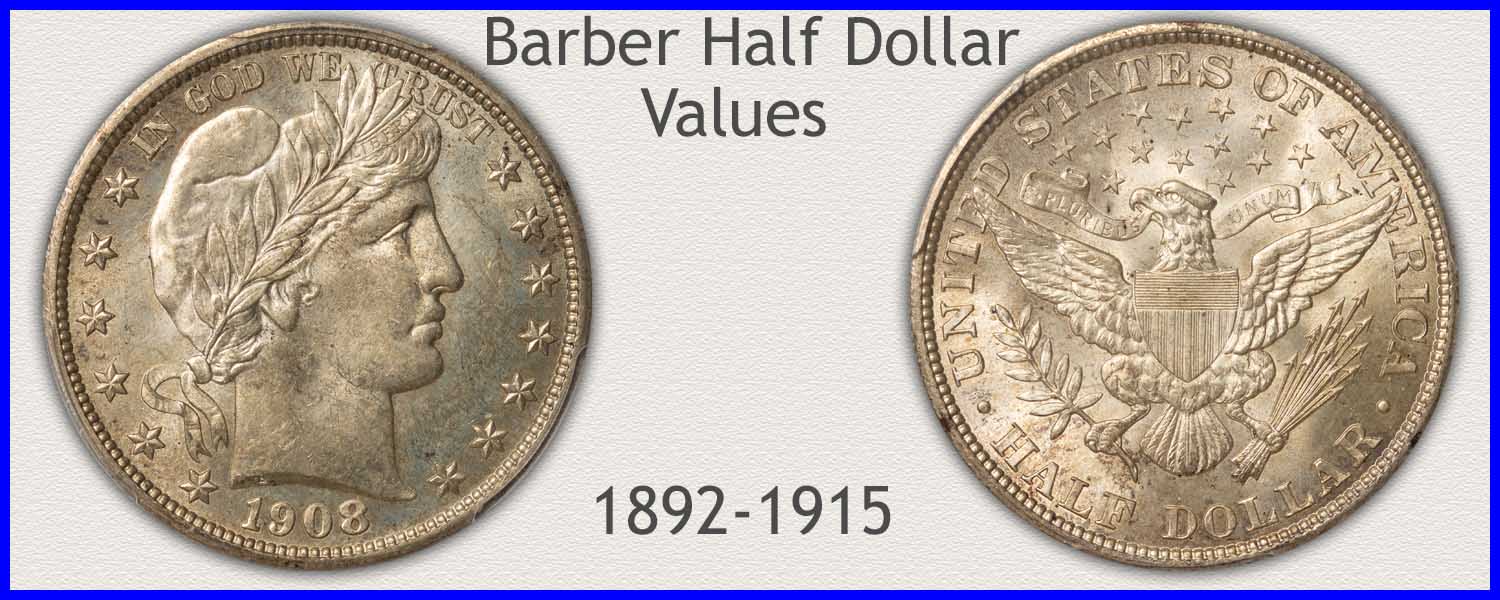Coin Values Moving with Precious Metals: Up-Dated 12/29/2025: Gold $4449 | Silver $75.46
1915 Half Dollar Value
To determine 1915 half dollar value, a few crucial features are recognized and judged.
The chart's values are refined by the coin's date, mint, and specific condition. Each of these factors is important to collectors, the hobbyists who create a market for old coins.
An organized approach allows for a thorough examination of the coin's most critical features. Recognize how much a Barber half dollar is worth, by confirming the date, mint issue, and condition. Proceed through the few steps below.
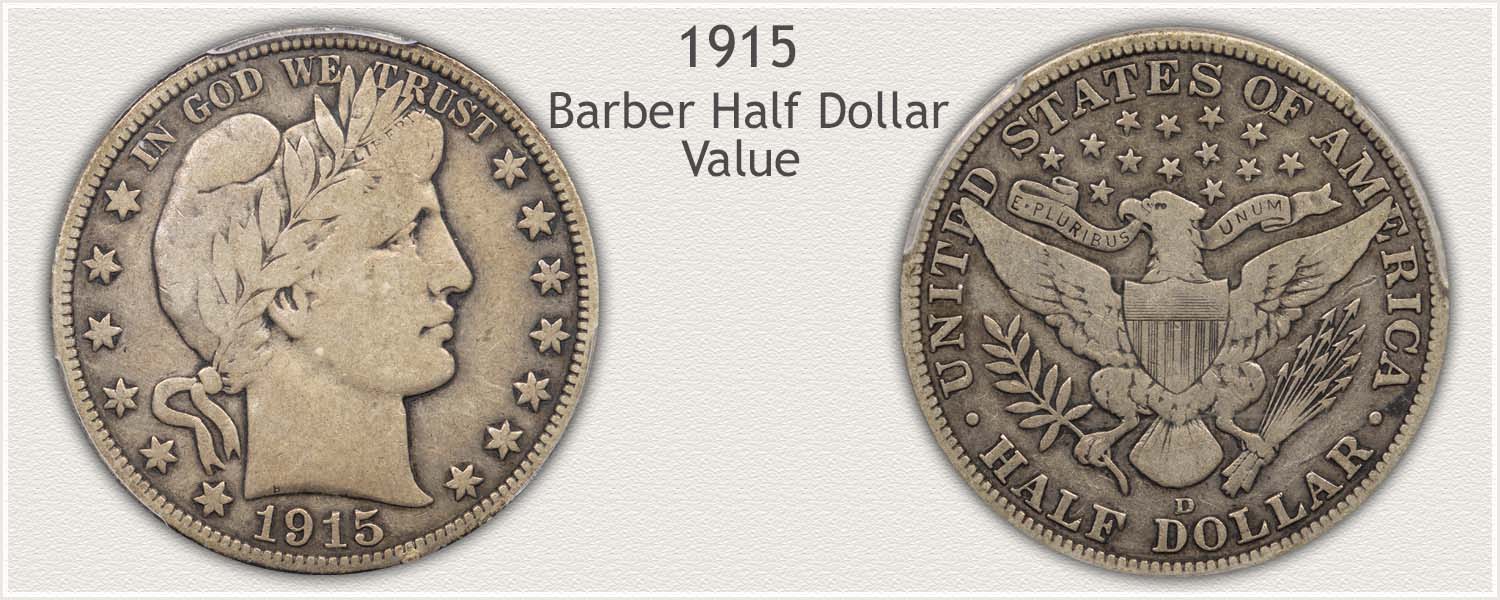
Steps Leading to Value:
- Step 1: Date and Mintmark Variety - There is a large swing in value depending on the mint producing a 1915 half dollar. All mint issues are collected, judged, and valued individually.
- Step 2: Grading Condition - Using descriptions of condition, determine the degree of preservation of your Barber half dollar. Eye-appealing examples are highly desirable, worth a premium to collectors.
- Step 3: Special Qualities - 1915 became the last year of the series with notable special coins produced during its production. A large coin and many collectible examples available help its popularity.
| 1915 Half Dollar Value | ||||
|---|---|---|---|---|
| Condition of Coin | ||||
| Date | Good | Fine | Extremely Fine | Mint State |
| Barber Half Dollar Values Updated | 12/29/2025 | |||
| 1915 | $49 | $155 | $475 | $1,091 |
| 1915 D | $44.95 | $66 | $169 | $346 |
| 1915 S | $42.74 | $68 | $132 | $409 |
Values listed are a range Barber Halves trade wholesale. The steps below are used to narrow the value range.
Step 1: | Date and Mintmark - Three Different Varieties
1915 Half Dollar Value Depends on Mint of Issue
Philadelphia mint leads in the value of 1915 half dollars. Philadelphia's issue is one of three varieties struck in the year. Two additional Branch mints contributed coinage, notably in far larger numbers.
With the large range in premiums noted on the chart for both mint variety and condition; a close inspection is needed. Images help confirm the important mintmarks.
1915-S Barber Half Dollar
"S" Mintmark on Reverse: San Francisco Mint Struck the Coin
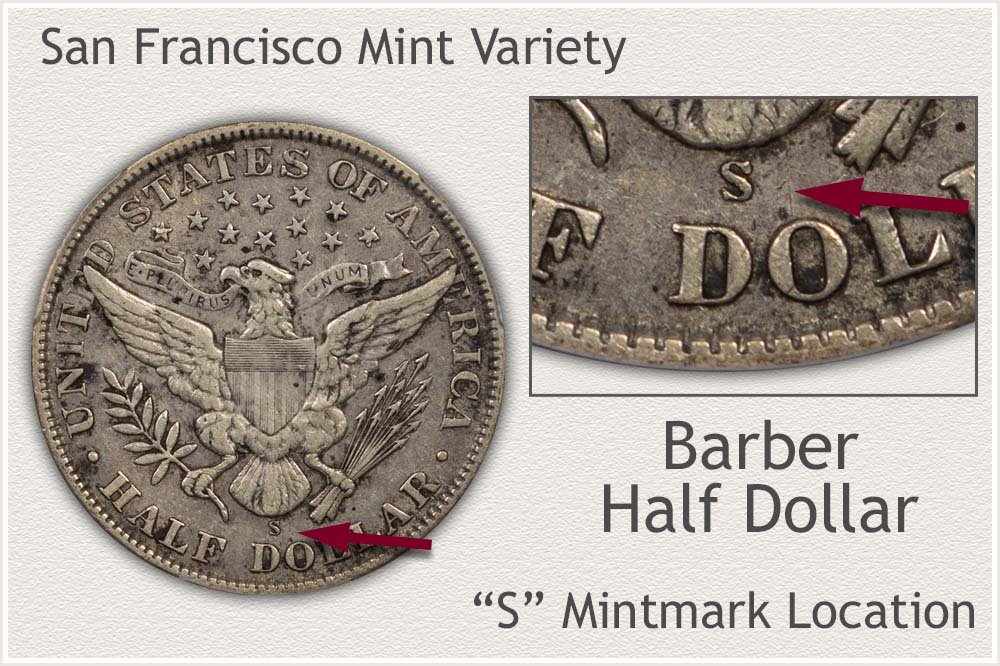
San Francisco variety half dollars were produced in sufficient numbers in 1915 to satisfy commercial demand. Total number of halves released into circulation was 1,604,000. These became the last of the series and stayed in circulation for a long time. Many heavily worn examples are available today, and their value is affected by the ups and downs in the price of silver. It is rare to find examples with just minor evidence of circulation. As indicated by the chart, a thorough evaluation of their state of preservation is required.
Confirming mint variety and then condition - grading its surfaces - narrows the price range. To distinguish its coinage, San Francisco used a "S" mintmark on each Barber half dollar. The "S" mintmark on the reverse, below the eagle, Identifies the San Francisco variety.
1915-D Barber Half Dollar
"D" Mintmark on Reverse: Denver Mint Struck the Coin
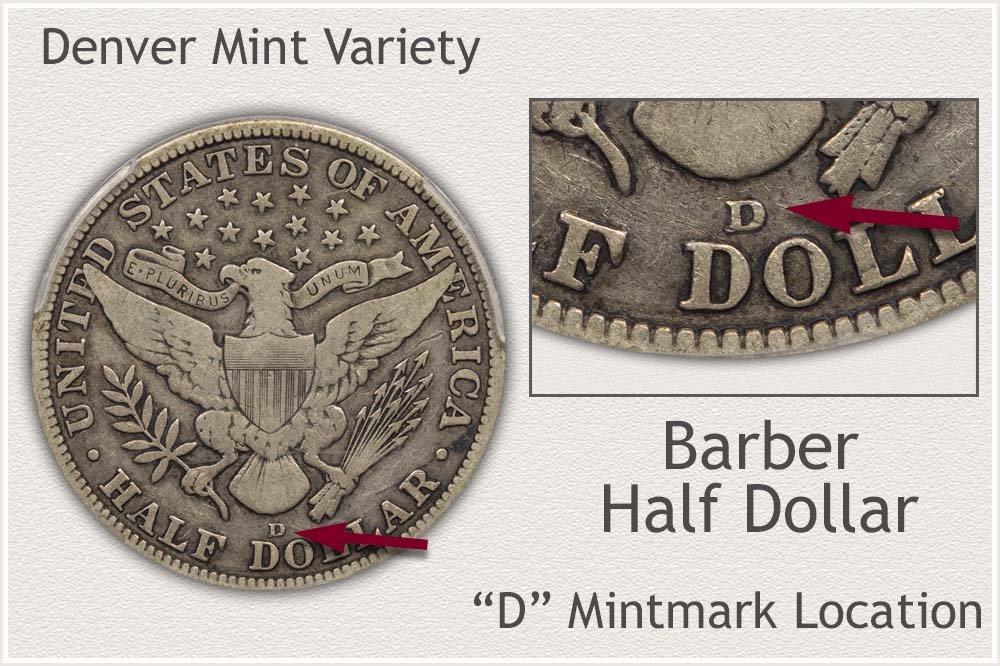
Half dollar production slowed at the Denver mint in 1915. Efforts were under way to end the Barber series of halves and begin the Walking Liberty design of 1916. Of the 1.7 million Denver issue half dollars minted in 1915 the majority were used heavily in circulation. The result is these well-worn examples are valued close to silver value. Any in above average condition are infrequently found and show a strong collector premium.
As the ending year of a design series, these remain popular with collectors. With strong markets supporting value, both the silver market and collectible market, date and mint variety is important to recognize.
Branch mints identify their production by placing mintmarks on their coinage. Denver struck all Barber halves with a "D" mark on the reverse. Just above the "DO" letters of DOLLAR is the "D" mintmark seen on the example, confirming the Denver mint variety.
1915 Barber Half Dollar
No Mintmark on Reverse: Philadelphia Mint Struck the Coin
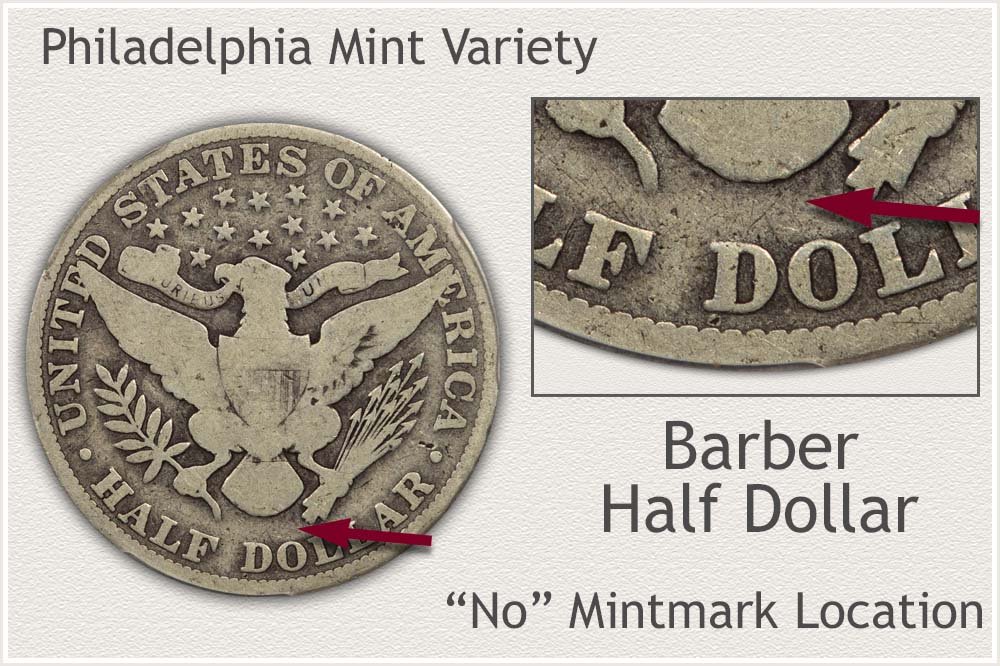
At the ending of the Barber series, the Philadelphia mint continued a trend of striking limited quantities of half dollars. 1915 production was restricted to just over 138,000 coins. This number became the second lowest mintage year of the series. A 1915 Philadelphia half dollar is scarce and considered an important issue of the entire Barber design. Identifying the variety correctly recognizes a highly sought-after collectible. This significantly low mintage draws attention from collectors resulting in heightened demand.
Examining the reverse closely is needed to recognize the valuable issue. Near the bottom of the coin, above the "D" in "Dollar," there is a blank area. This confirms the half dollar was struck in Philadelphia.
Step 2: | Grading Inspects the Half Dollar for Remaining Details
A High-Quality Coin Displays Key Features of Remaining Design
To define their surface condition, collectible coins are judged and graded. Most coins from 1915 remaining today show substantial signs of wear. Premium quality examples have a value significantly higher than the base value of silver within the coin.
Grading terms are used by collectors to describe condition and categorize stages of wear. Indicators such as flattened areas and the blending of small design elements are features used in identification of these stages of wear. As part of the grading process, magnification is helpful in recognizing the smaller, more subtle differences on the coin.
Mint State Grade
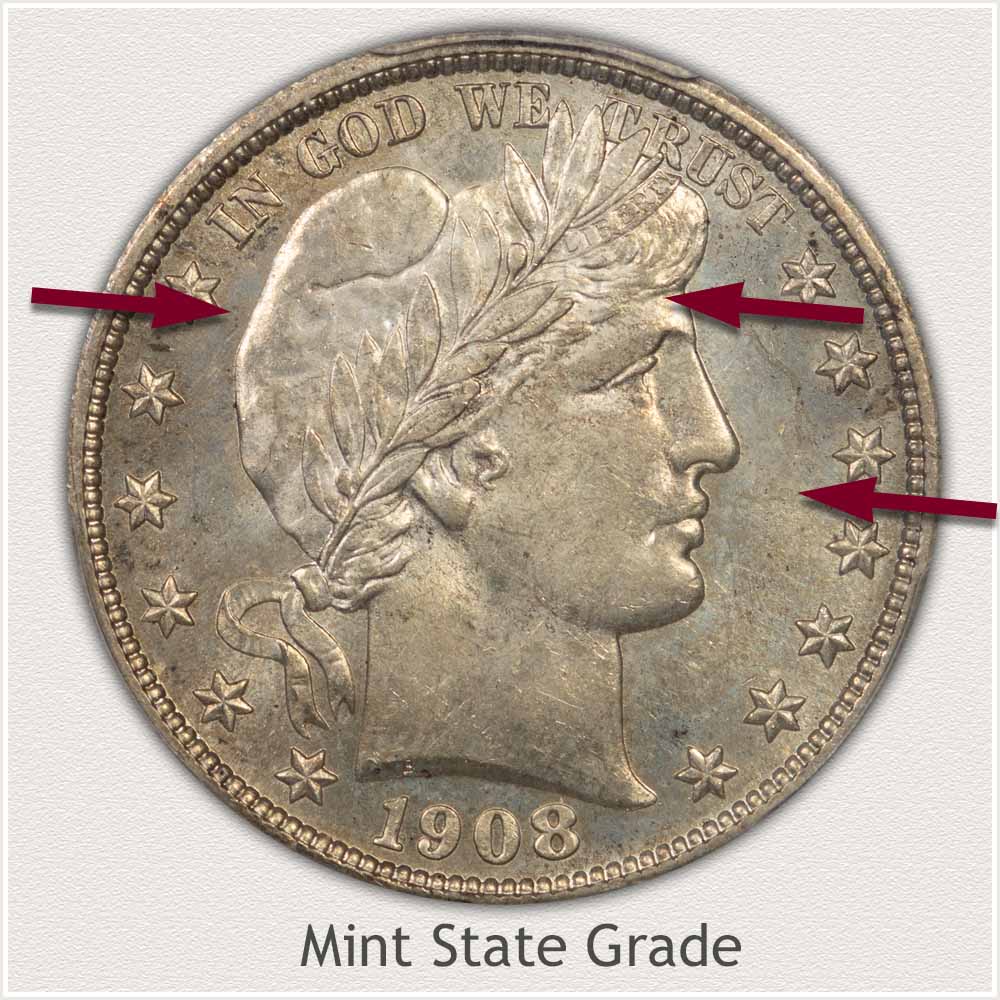
Mint State: A Barber half graded as being in Mint Condition has a surface that is completely free of any signs of wear. Areas of small, elevated design features are quickly flattened by wear. Undisturbed surfaces retain their luster, or shine, without being smoothed.
Inspect closely Liberty's hair above her forehead on the example half dollar. Fine strands of hair have not flattened, indicating the surface has not been worn. There are no dull spots or smooth areas along the hairline to the ear, and the metal remains with a fine texture. A dull gray color appears in this area if wear is present.
Additionally, open areas of Liberty's cap still retain a brilliance and luster that has not been disturbed. Also, the fine texture of shine still covers the cap's outer edge. It is helpful to magnify your coin and tilt it under a single light source in order to recognize these details.
Extremely Fine Grade
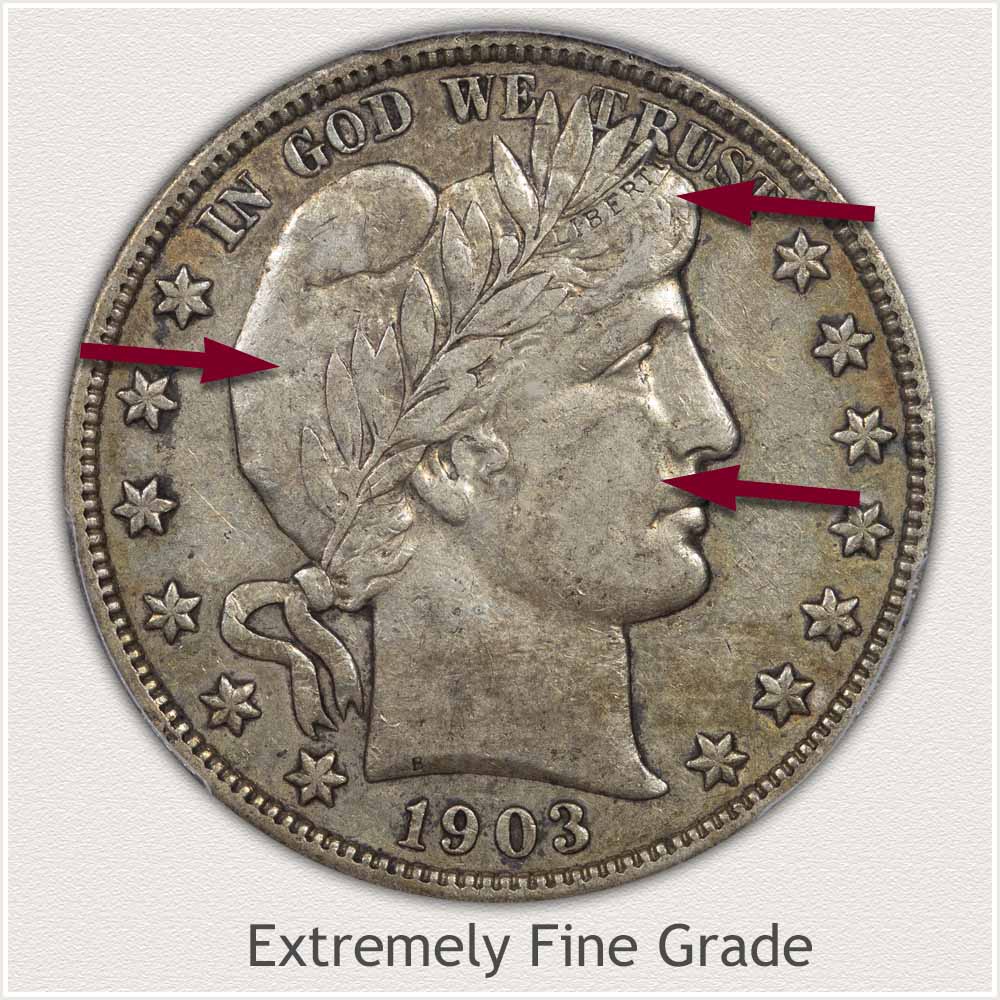
Extremely Fine: Finding a Barber half dollar with excellent detailing is identifying an infrequently found and collectible coin. Extremely Fine condition and grade are defined by light wear over the entire surface, only smoothing the very high points.
On these lightly circulated half dollars a delicate silver-gray color has replaced most of the previous brilliance. Upon examining the headband, all letters of "Liberty" are clearly readable, an important metric for the grade. Furthermore, the top and bottom edges of the headband are visible, indicating only light wear and Extremely Fine condition.
Liberty's portrait has a "fullness" and rounded cheek in an overall view of the coin. Her face has only been lightly smoothed, and high and low relief contours remain. Overall, the coin has a sharply detailed appearance.
Fine Grade
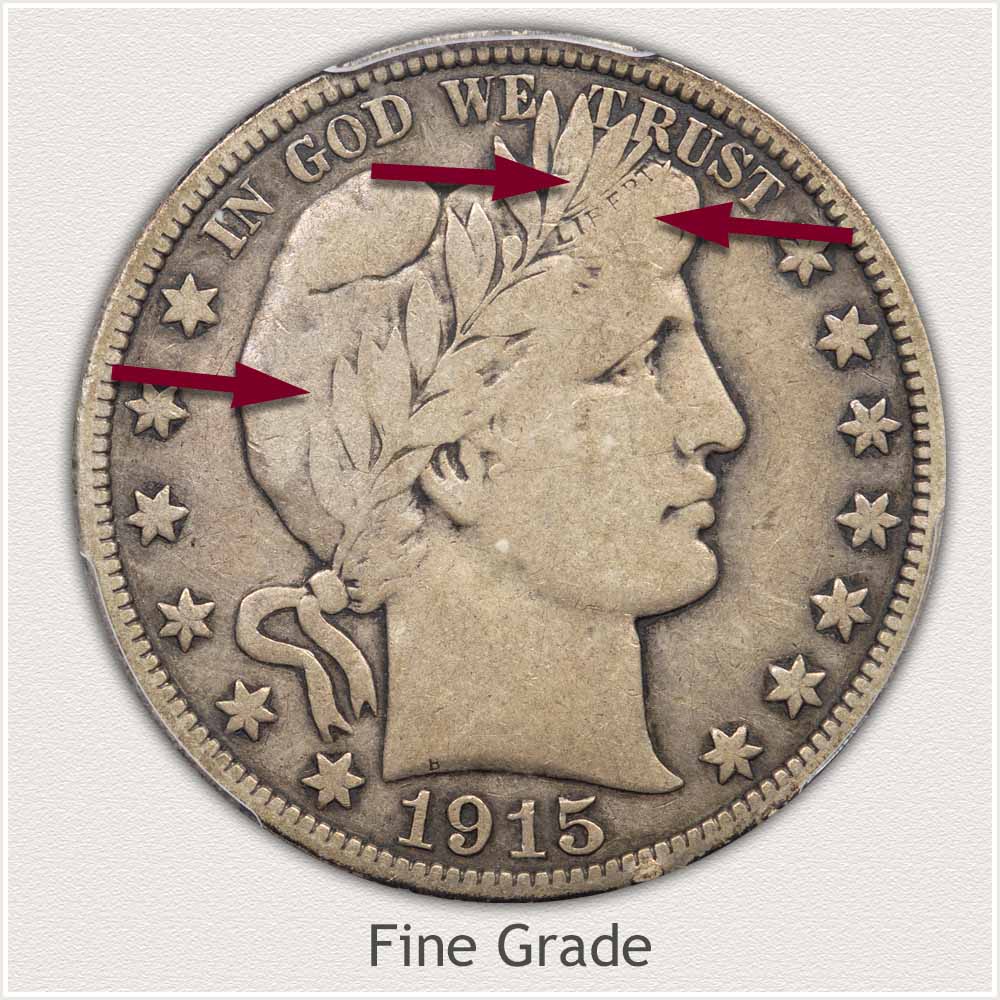
Fine Grade: Each stage of wear on a Barber half dollar is identified by looking for a distinct wear pattern. A Fine grade is distinguished by moderate wear, which is defined by certain design features that remain.
Liberty's forehead and the wreath of Laural leaves that extends to her lower ear are high areas of relief that are quick to wear first. Merging of the headband and hair is noticeable on the forehead. Also worn smooth is the lower edge of the band. However, the entire "LIBERTY" lettering is visible, which is a requirement for the Fine grade.
In her hair, the wreath's leaves have sharper definition along the top row. Except for a slight merging toward the high area above her forehead, all leaf edges are clearly defined. Most of the leaf edges along the bottom row have faded into the Liberty's hair.
A Fine grade coin is of collectible quality, with smooth surfaces throughout and clear edges to most small details. A soft gray color to the silver and boldness of Liberty's portrait strengthens the condition's appeal.
Good Grade
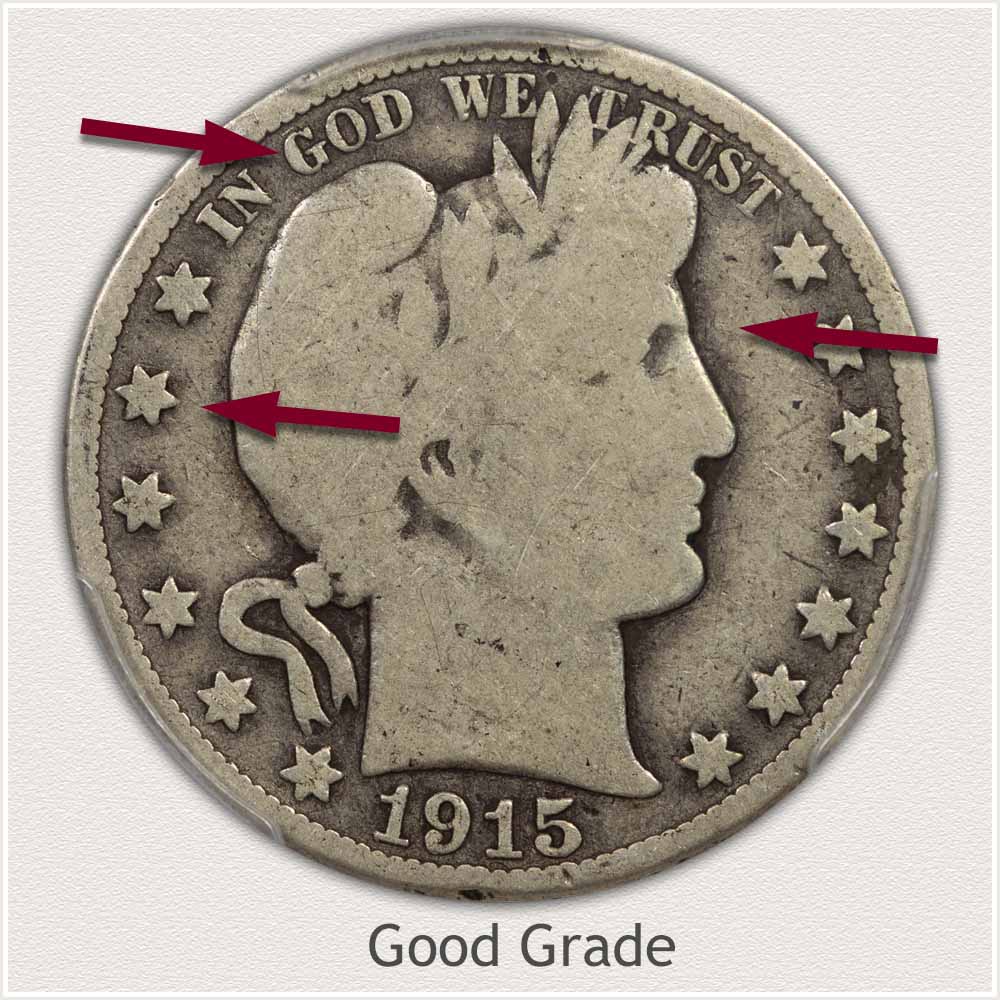
Good Grade: In contrast to a lower quality coin, the details that remain visible in the "Good" grade are strong and bold. Few of these coins remain collectible once the rim has merged with the lettering of the motto and Liberty's portrait has faded into the fields.
Over time, heavy wear has flattened and smoothed Liberty's entire design. The condition is defined by the lack of central detail, with few details visible. These coins are referred to as Good Grade. However, the complete outline of Liberty is bold keeping the example half dollar well within the "Good" grade range. Liberty still stands out above the coin's field despite its wear.
It is also important to confirm lettering and stars along the rim are not merging with the rim. This clear separation of rim lends the coin the visual appeal to achieve the Good grade. Additionally, the date is very strong and clear, in an area protected by the rim and neck. Wear without a faded look, plus the complete rim, is an attractive collectible.
How to Video: Grading Barber Half Dollars
Expand the grading process to help confirm a narrow grade. Condition is often a large factor when placing a value on these Barber half dollars.
Video, Images and Descriptions | Grading Barber Half Dollars
Step 3: | Special Qualities Enhancing Value
Scarcity of Barber Half Dollars
A total of 135 million Barber half dollars were minted and released into circulation in the 24 years of the series. Between 1892 and 1915, not all date and mint combinations were produced in equal amounts. An interesting series of very high mintage varieties offset by very low mintage numbers. An overall view shows a dramatic variance.
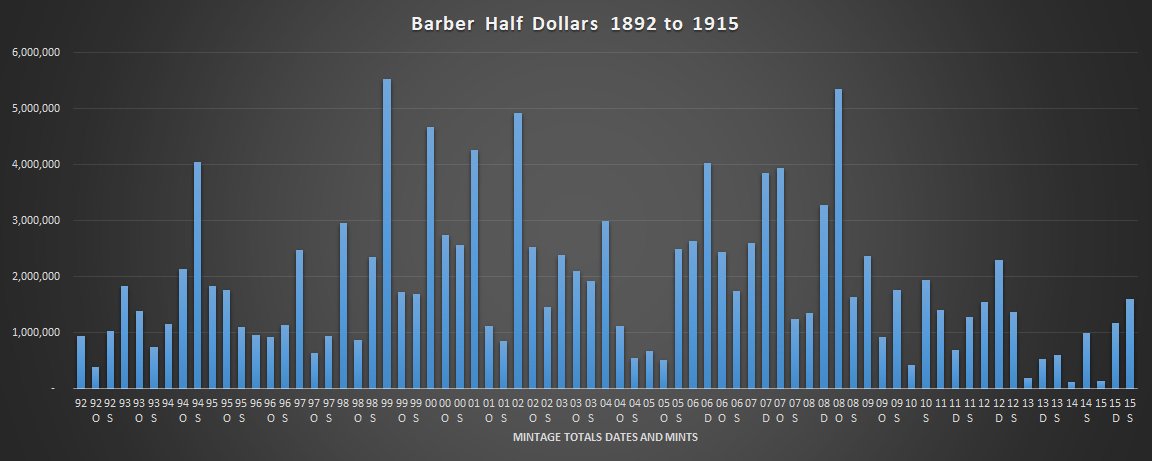
A key factor in value is the availability of the different dates and mints. Collectors place a demand on all Barber halves, difficult coins to locate become premium in value. Initial production numbers begin to highlight potential scarce issues when displayed against high mintage varieties.
Very high mintages are noted, very low numbers stand out, and issues between are recognized.
Philadelphia mint half dollars of 1913, 1914, and 1915 are at the extremes of low production numbers. Never abundant, these are now a highly prized variety in all stages of wear. Lack of saving examples at the time is also seen in the values of the low mintage branch mint coinage. 1892-O (New Orleans) and 1893-S (San Francisco) halves are early, scarce dates and mints.
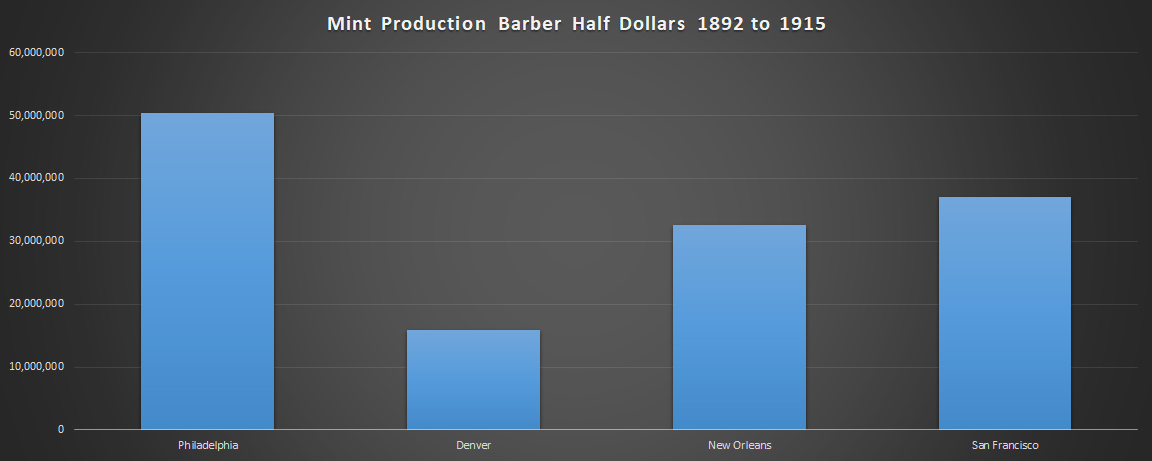
A view of total production comparing the different mints records Philadelphia coinage above all branch mints. Philadelphia struck halves each year of the series.
San Francisco is the other mint striking halves each year and is showing fewer yearly average numbers. Especially in the early era of the series, low numbers coined by San Francisco leads to high value half dollars.
Although Denver posts low total series numbers, the number of years involved is seven. New Orleans is an original mint starting the Barber series, however ended coinage operations in 1909, lowering overall totals.
One factor contributing to today's existing supply of Barber half dollars was continued withdrawal of old coinage from circulation. Each year, vast numbers of coins are melted and used to mint new coins.
As an example: in 1935, twenty years after the last Barber half was minted, a total of over 7 million half dollars were recorded by the mint as melted and recoined for circulation. These coins, released from Treasury stock, undoubtedly contained many heavily worn and unfit for use Barber half dollars.
Any nice condition Barber half dollar is a special coin, large and 90% silver alloy, and with luck, avoided recoinage.
References
U.S. Mint. 1916 U.S. Mint Annual Report.
https://nnp.wustl.edu/library/book/514129
U.S. Mint. 1936 U.S. Mint Annual Report
https://nnp.wustl.edu/library/book/514140
Coin Values | CoinStudy Articles
Date by Date
In Depth Barber Half Dollar Values
1892 to 1915
Barber Half Dollar Value | Scarce Low Mintages
Many dates of the Barber half dollar series are scarce because of low mintages, these coins standout on the full value chart with high premiums. Identify the important factors to narrow how much an old half dollar is worth.
Coin Value Guide | How to Value a Coin Collection
Date runs of coins assembled as collections are valued by following a few steps. Identify series, dates and mint varieties, and then an overall assessment of condition. Higher premium coins are quickly recognized. Understand the potential in an old coin collection.
Print the Coin Values Worksheet
Organized into one list, print and record values of your Barber half dollars. Print extra sheets to continue with the rest of your holdings.
Safe Coin Storage | Recommendations
Once removed from circulation and then providing protective housing, old coins maintain value. Specific to coins and coin collecting are storage options to hold single or multiple coins. Premium coins are protected and safe from damage. Review the storage solutions.
Selling Coins | A Defined Process
First organize your coins to accurately identify each. Placing a narrow value range on the coin prepares for the selling step. Follow the process used by collectors to finding dealers suitable to contact from the dealer listings.
★Coin Values Discovery finds 1915 Barber Half Dollar Value and...
U.S. coin value charts plus a step-by-step method, finds a narrow range to how much old coins are worth. Begin here with in-depth coverage of the important features to identify on each coin. Dates plus mint varieties are identified, judging condition with images and video; also identifying special qualities finds the potential in a box of old coins.
